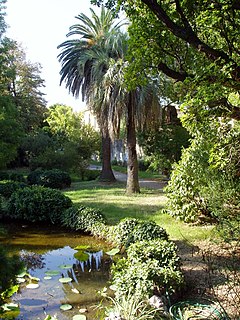
Royal Botanic Gardens, Kew, is a non-departmental public body in the United Kingdom sponsored by the Department for Environment, Food and Rural Affairs. An internationally important botanical research and education institution, it employs 1,100 staff. Its board of trustees is chaired by Dame Amelia Fawcett.

The Mimosoideae are trees, herbs, lianas, and shrubs that mostly grow in tropical and subtropical climates. They comprise a clade, previously placed at the subfamily or family level in the flowering plant family Fabaceae (Leguminosae). In previous classifications, Mimosoideae refers to what was formerly considered the tribe Mimoseae. Characteristics include flowers in radial symmetry with petals that are valvate in bud, and have numerous showy, prominent stamens. Mimosoideae comprise about 40 genera and 2,500 species.

A botanical garden or botanic garden is a garden dedicated to the collection, cultivation, preservation and display of a wide range of plants labelled with their botanical names. It may contain specialist plant collections such as cacti and other succulent plants, herb gardens, plants from particular parts of the world, and so on; there may be greenhouses, shadehouses, again with special collections such as tropical plants, alpine plants, or other exotic plants. Visitor services at a botanical garden might include tours, educational displays, art exhibitions, book rooms, open-air theatrical and musical performances, and other entertainment.

The Missouri Botanical Garden is a botanical garden located at 4344 Shaw Boulevard in St. Louis, Missouri. It is also known informally as Shaw's Garden for founder and philanthropist Henry Shaw. Its herbarium, with more than 6.6 million specimens, is the second largest in North America, behind that of the New York Botanical Garden.

Senegalia senegal is a small thorny deciduous tree from the genus Senegalia, which is known by several common names, including gum acacia, gum arabic tree, Sudan gum and Sudan gum arabic. In parts of India, it is known as Kher or Khor. It is native to semi-desert regions of Sub-Saharan Africa, as well as Oman, Pakistan, west coastal India. It grows to a height of 5–12 metres (16-40'), with a trunk up to 30 cm (1') in diameter. Sudan is the source of the world's highest quality gum arabic, known locally as hashab gum in contrast to the related, but inferior, gum arabic from Red acacia or talah gum.

Acacia, commonly known as the wattles or acacias, is a large genus of shrubs and trees in the subfamily Mimosoideae of the pea family Fabaceae. Initially, it comprised a group of plant species native to Africa and Australasia, but it has now been limited to contain only the Australasian species. The genus name is New Latin, borrowed from the Greek ἀκακία, a term used by Dioscorides for a preparation extracted from the leaves and fruit pods of Vachellia nilotica, the original type of the genus. In his Pinax (1623), Gaspard Bauhin mentioned the Greek ἀκακία from Dioscorides as the origin of the Latin name.

Senegalia rugata, commonly known in India as shikakai, is a spiny climbing shrub native to China and tropical Asia, common in the warm plains of central and south India. It is renowned as a raw material for shampoo, while the leaves and young shoots are often eaten. Archaeobotanical evidence shows its use for hair care in the pre-Harrapan levels of Banawali, some 4500-4,300 years ago.
Leslie Pedley was an Australian botanist who specialised in the genus Acacia. He is notable for bringing into use the generic name Racosperma, creating a split in the genus with some 900 Australian species requiring to be renamed, since the type species of Acacia, Acacia nilotica, now Vachellia nilotica, had a different lineage from the Australian wattles. However, the International Botanical Congress (IBC) in Melbourne in 2011 ratified their earlier decision to retain the name Acacia for the Australian species and to rename the African species.

Senegalia mellifera is a common thorn tree in Africa. The name mellifera refers to its sweet-smelling blossoms and honey. Its lumber turns pitch black when oiled. Common names of the tree include Blackthorn and Swarthaak (Afrikaans). It is listed as being not threatened.

Senegalia is a genus of flowering plants in the family Fabaceae. It belongs to the Mimosoid clade. Until 2005, its species were considered members of Acacia. The genus was considered polyphyletic and required further division, with the genera Parasenegalia and Pseudosenegalia accepted soon after. Senegalia can be distinguished from other acacias by its spicate inflorescences and non-spinescent stipules. Plants in the genus are native to the tropical and subtropical areas of the world, occurring on the Australian, Asian, African and South and North American continents, as well as in Wallacea.
Senegalia pervillei is a species of Senegalia that is endemic to Madagascar. The species was first formally described by English botanist George Bentham in 1875 in Transactions of the Linnean Society of London. Two varieties are recognised:
Senegalia sakalava is a species of Senegalia that is endemic to Madagascar. Two varieties are recognised:

Senegalia caffra, also known as hook-thorn or Acacia caffra, is a tree that occurs commonly in southern Africa. Though it is cultivated, it often occurs naturally in Gauteng suburban gardens, together with Acacia karroo and Acacia robusta.

Senegalia modesta is a species of plant commonly found in Pakistan, India and Afghanistan. S. modesta is a perennial tree and formerly, it was classified as Acacia modesta. The plant is drought tolerant. S. modesta`s tree grow in medium size deciduous form with rough surfaced, brown or greenish grey bark, leaflets as, cream colored inflorescence in the form of pedunculate spike, pods as stipitate having 3-5 seeds inside.

Vachellia abyssinica, the flat top acacia, is a tree up to 16 m tall. Its bark is reddish-brown on older trees. On younger trees it is pale yellowish-brown, peeling off in papery wads. Young twigs are softly hairy. Thorns are aligned in straight pairs at nodes. Leaves are in pinnae pairs of 20-40; the leaflets are very small, up to 4 × 0.75 mm. The inflorescence is arranged in white spherical heads. The involucel is located in the lower half of the peduncle. Seed pods are dehiscent.

The National Herbarium of New South Wales was established in 1853. The Herbarium has a collection of more than 1.4 million plant specimens, making it the second largest collection of pressed, dried plant specimens in Australia, including scientific and historically significant collections and samples of Australian flora gathered by Joseph Banks and Daniel Solander during the voyage of HMS Endeavour in 1770.

World Flora Online is an Internet-based compendium of the world’s plant species.
Senegalia thailandica is a species of climbing or sprawling shrub in the family Fabaceae.

Senegalia hayesii is a species of plant in the family Fabaceae. It is native to Bolivia, Costa Rica, Guatemala, Honduras, Mexico, Panamá, and Venezuela.
Senegalia megaladena is a spiny climber, shrub or tree, native to Jawa, and from mainland Southeast Asia to China and India. It is eaten as a vegetable and used as a fish poison. It is named after its distinctive large gland on the petioles.














